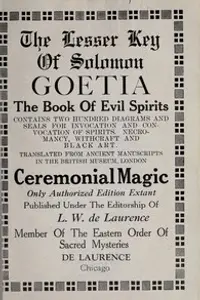Summary
The Lesser Key of Solomon, often attributed to anonymous 17th-century occult compilers, is one of the most famous grimoires in Western esoteric tradition.
The first section, known as the Goetia, details the conjuration and control of 72 spirits said to have been invoked by King Solomon, along with descriptions of their powers, hierarchies, and sigils.
Combining ritual instructions, invocations, and symbolic diagrams, the text provides insight into ceremonial magic as it was practiced and transmitted in early modern Europe.
More than a manual of sorcery, the work reflects a historical blending of Jewish mysticism, medieval demonology, and Renaissance occult philosophy.
Today it is studied as both a cornerstone of Western magical literature and a cultural artifact illustrating humanity’s enduring fascination with the unseen.
